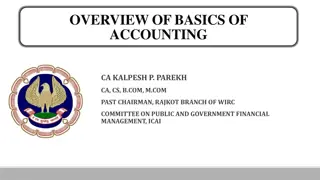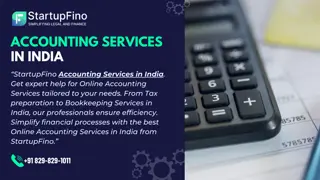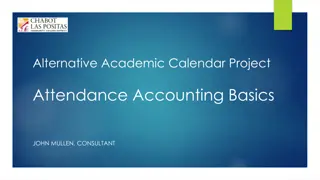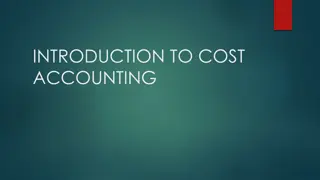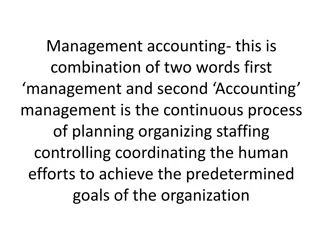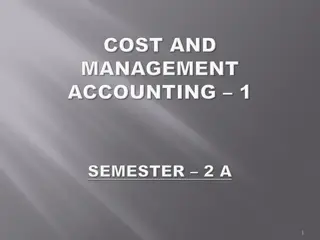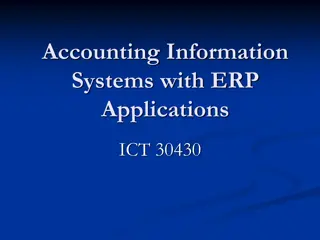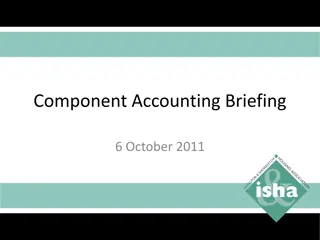Understanding Cost Accounting Essentials
This overview delves into topics such as financial accounting, classification of accounts, cost ascertainment, and management accounting. It covers the meaning of cost, methods and techniques of costing, advantages and limitations of cost accounting systems, and essentials for a robust cost accounting setup. Limitations of financial accounting are also discussed, highlighting the differences between financial and cost accounting, and the importance of cost and management accounting in determining product/service costs.
Download Presentation

Please find below an Image/Link to download the presentation.
The content on the website is provided AS IS for your information and personal use only. It may not be sold, licensed, or shared on other websites without obtaining consent from the author. Download presentation by click this link. If you encounter any issues during the download, it is possible that the publisher has removed the file from their server.
E N D
Presentation Transcript
OVERVIEW OF COST ACCOUNTING Chapter 1- Overview of cost account
Topics Financial accounting Classification of account Objectives and functions of cost accounting Meaning of Cost Methods of costing Techniques of costing Cost ascertainment and cost estimation Classifications of cost Special costs for management decision making Elements of cost Steps of installation of a costing system Advantages of cost accounting Limitations or objections against cost accounting Essentials of a good cost accounting system
CLASSIFICATION OF ACCOUNTING CLASSIFICATION OF ACCOUNTING 1. manner and in terms of money, transactions and events, which are in part at least, of a financial character and interpreting the results thereof. 2. Cost Accounting: Cost accounting is the process of accounting for costs from the point at which expenditure is incurred or committed to the establishment of its ultimate relationship with cost centres and cost units. In its widest usage, it embraces the preparation of statistical data, the application of cost control methods and ascertainment of profitability of activities carried out or planned. 3. Management Accounting: (CIMA), London has defined management accounting as the presentation of accounting information in such a way as to assist management in the creation of policy and in the day-to-day operations of an undertaking. Financial Accounting: It is defined as the art of recording, classifying and summarizing in a significant
Financial Accounting The functions of financial accounting are concerned with that of bookkeeping, i.e. maintenance of records of costs, debtors, and creditors, etc. As per the company law requirements, the company has to maintain the accounts for their adoption by the shareholders in the Annual General Meeting.
Limitations of Financial Accounting Financial accounting doesn t aims at continuous reporting of financial data, which the cost accounting does Financial accounts will not reveal the data by jobs, process, products, etc. It provides only historical data, and it would be too late for any corrective action. It does not provide data for adequate control over materials, labour, and overheads. In financial accounting, there are no systems to set predetermined estimates, standards, or budgets.
Cost and Management Accounting The Chartered Institute of Management Accountants, U.K. (CIMA) defines costing as the technique and process of ascertaining costs. Costing is a tool to determine the cost of products or service. Cost accounting analysis and classification of costs or expenditure. Cost accountancy application of costing and cost accounting principles.
Cost Accounting and Management Accounting To quote J. Batty, Management Accountancy is the term used to describe the accounting methods, systems and techniques, which coupled with special knowledge and ability, assists management in its tasks of maximizing profits or minimizing losses. Management Accountancy is the blending together into a coherent whole, financial accounting, cost accountancy and all aspects of financial management. Management Accounting is an extension of managerial aspects, of cost accounting. Thus, it is the accounting to assist the management in planning and decision- making.
OBJECTIVES AND FUNCTIONS OF COST ACCOUNTING OBJECTIVES AND FUNCTIONS OF COST ACCOUNTING Ascertainment of cost: In cost accounting, cost of each unit of production, job, process or department, etc., is ascertained. Not only actual costs incurred are ascertained but costs are also pre-determined for various purposes. Cost control and cost reduction Cost accounting aims at improving profitability by controlling and reducing costs. For this purpose, various specialized techniques, like standard costing, budgetary control, inventory control, value analysis, etc., are used. Guide to business policy Cost accounting aims at serving the needs of the management in conducting the business with utmost efficiency. Cost data provide guidelines for various managerial decisions, like making or buying, selling below cost, utilization of idle plant capacity, introduction of a new product, etc. Determination of selling price Cost accounting provides cost information on the basis of which selling prices of products or services may be fixed. In periods of depression, cost accounting guides the firms in deciding the extent to which the selling prices may be reduced to meet the situation.
MEANING OF COST MEANING OF COST According to Cambridge International Dictionary of English, cost means the amount of money needed to buy, do or make something. Some other definitions of cost are given below: 1. Cost is the amount of expenditure (actual or notional), incurred or attributable to a given thing. (CIMA, London) 2. A cost is the value of economic resources used as a result of producing or doing the things costed. (W M Harper) 3. Cost is a measurement, in monetary terms, of the amount of resources used for the purpose of production of goods or rendering of services. (ICWA of India) Cost Unit Cost Object Cost Centre
Cost Unit and Cost centre A cost centre is a location, a person, or an item of equipment (or a group of these) for which costs may be ascertained and used for the purpose of cost control. Cost unit is defined as a quantitative unit of a product, a service, or an item, in relation to which costs are measured. A cost unit, simply stated, is a unit of finished product, service or time, or a combination of these in relation to which cost is ascertained and expressed. Ex:- Product Cost unit Cement Per tone Cable Per MTR.
Types of Cost Centers Personal (Sales manager, work managers) and impersonal cost (Region sales, Territory purchase) centre Operation and process cost centre Production, service and staff cost centre Whatever may be the type of cost centre, it is determined by taking into consideration the following factors: the value of the work to be performed, the extent of cost control that can be exercised, responsibilities to be identified, and the uses of cost centre wise data by the costing department, etc.
Cost Object Cost object is anything for which separate cost may be desired Cost object is an entity or a part of an entity The cost object changes according to decision needs of the management. Ex: Product, Group of Product, Plant, division, Project etc.
Cost, Expense, and Loss The term cost is denoted by expense which is incurred after deriving the benefit. When the cost is incurred before deriving the benefit, it is termed as deferred cost. Expenses are defined as all explicit costs which are deductible from revenue. When no benefit is derived by the incurrence of cost, it is termed as loss,
METHODS OF COSTING METHODS OF COSTING Job order costing: Cost unit in job order costing is taken to be a job or work order for which costs are separately collected and computed. Contract costing or terminal costing: The cost unit here is a contract which is of a long duration and may continue over more than one financial year. Batch costing: In this, cost of a batch or group of identical products is ascertained and therefore each batch of products is a cost unit for which costs are ascertained. Process costing: This method is used in mass production industries manufacturing standardized products. Costs are accumulated for each process or department. Operation costing: A process may consist of a number of operations and operation costing involves cost ascertainment for each operation instead of a process. product. Single, output or unit costing: This method is used when production is uniform and consists of a single or two or three varieties of the same Operating or service costing: It is used in undertakings which provide services instead of manufacturing products.
TECHNIQUES OF COSTING TECHNIQUES OF COSTING Standard costing In this technique, standard cost is predetermined as target of performance, and actual performance is measured against the standard. Budgetary control It is a technique applied to the control of total expenditure by comparing actual performance with planned performance. Marginal costing In this technique, separation of costs into fixed and variable (marginal) is of special interest and importance. Total absorption Marginal costing In this technique, separation of costs into fixed and variable (marginal) is of special interest and importance. It is a traditional method of costing whereby total costs (fixed and variable) are charged to products. Uniform costing In this technique, separation of costs into fixed and variable (marginal) is of special interest and importance.
CLASSIFICATIONS OF COST CLASSIFICATIONS OF COST Classification into Direct and Indirect Costs Direct costs: Costs which are incurred for and conveniently identified with a particular cost object. Indirect costs These are general costs and are incurred for the benefit of a number of cost object. Classification into Fixed , Variable and Semi-variable Costs Semi-variable or semi-fixed costs (mixed costs): These costs include both a fixed and a variable component. Fixed costs : These remain constant over a specific range of activity for a specified period of time. Variable costs :Cost that tend to vary in direct proportion to the volume of output. Classification into Committed and Discretionary Costs Committed costs: These are those costs that are incurred in maintaining physical facilities and managerial set up. Discretionary costs: Costs which can be avoided by management decisions. Such costs are not permanent.
CLASSIFICATIONS OF COST(Contd.) CLASSIFICATIONS OF COST(Contd.) Classification into Product Costs and Period Costs Period costs: These are those costs which are not necessary for production and are incurred even if there is no production. Product costs: These costs include all such costs that are involved in acquiring or making a product. Classification into Controllable and Non- controllable Costs Non-controllable costs: Costs which cannot be influenced by the action of a specified member of an enterprise. Controllable costs: Costs which may be directly regulated at a given level of management authority. Classification into Historical Costs and Predetermined Costs Historical costs: Costs which are ascertained after these have been incurred. Predetermined costs: Future costs which are ascertained in advance of production. Classification into Normal and Abnormal Costs Normal cost: Cost which is incurred on expected lines at a given level of output. Abnormal cost: Cost which is not normally incurred at a given level of output.
ELEMENTS OF COST ELEMENTS OF COST
SPECIAL COSTS FOR MANAGEMENT DECISION MAKING SPECIAL COSTS FOR MANAGEMENT DECISION MAKING 1. Relevant costs: Cost whose magnitude will be affected by decision being made. 2. Irrelevant costs: These are those costs that will not be affected by a decision. 3. Sunk Costs: A sunk cost is an expenditure made in the past that cannot be changed and over which management no longer has control. 4. Differential (or Incremental) Cost: This cost may be regarded as the difference in total cost resulting from a contemplated change. 5. Marginal Cost: Marginal cost is the additional cost of producing one additional unit. Marginal cost is the same thing as variable cost. 6. Imputed Costs: These are hypothetical costs which are specially computed outside the accounting system for the purpose of decision making. 7. Opportunity Cost: It is the sacrifice involved in accepting an alternative under consideration. 8. Replacement Cost: This is the cost at which there could be purchased an asset identical to that which is being replaced. 9. Out - of - pocket Cost (Explicit Cost and Implicit Cost ): These are those costs that involve cash outlays or require the utilization of current resources. 10. Future Cost: Relevant costs for decision making are predetermined or future costs. 11. Conversion Cost: It is the total cost of converting a raw material into finished product.
COST ASCERTAINMENT AND COST ESTIMATION COST ASCERTAINMENT AND COST ESTIMATION Cost Ascertainment: Cost ascertainment is concerned with computation of actual costs incurred. It refers to the methods and processes employed in ascertaining costs. The ascertainment of actual cost has very little utility because of the following reasons: 1. Actual costs cannot be used for the purpose of price quotations and filling tenders. 2. Actual cost has practically no utility for cost control purposes. 3. Actual costs are ineffective as means of measuring performance efficiency. Cost Estimation: Cost estimation is the process of predetermining costs of goods or services. The costs are determined in advance of production and precede the operations. Cost estimates may have the following uses: 1. 2. Cost estimates are used in the preparations of budgets. 3. They help in evaluating performance. 4. They are used in preparing projected financial statements. 5. Cost estimates may serve as targets in controlling the costs. Cost estimates are used in making price quotations and bidding for contracts.
ADVANTAGES OF COST ACCOUNTING ADVANTAGES OF COST ACCOUNTING Advantages to Management: Reveals profitable and unprofitable activities, Helps in cost control, Helps in decision making, Guides in fixing selling prices, Helps in inventory control, Aids in formulating policies, Helps in cost reduction, Reveals idle capacity, Checks the accuracy of financial accounts, Prevents frauds and manipulation. Advantages to Workers: Workers are benefited by introduction of incentive plans which are an integral part of a cost system bringing higher productivity and higher earnings for them. Advantages to Society: An efficient cost system is bound to lower the cost of production, the benefit of which is passed on to the public at large, in the form of lower prices of products or services. Advantages to Government Agencies and Others: A cost system produces ready figures for use by government, wage tribunals, chambers of commerce and industry trade unions, etc., for use in problems like price fixing, wage level fixing, settlement of industrial disputes, policy matters, etc.
LIMITATIONS OR OBJECTIONS AGAINST LIMITATIONS OR OBJECTIONS AGAINST COST ACCOUNTING COST ACCOUNTING It is unnecessary It is argued that maintenance of cost records is not necessary and involves duplication of work. It is based on the premise that a good number of concerns are functioning prosperously without any system of costing. It is expensive It is pointed out that installation of a costing system is quite expensive which only large concerns can afford. It is also argued that installation of the system will involve additional expenditure which will lead to a diminution of profits. It is inapplicable Another argument sometimes put forward is that modern methods of costing are not applicable to many types of industry. It is a failure The failure of a costing system in some concerns is quoted as an argument against its introduction in other undertakings.
STEPS OF INSTALLATION OF A COSTING STEPS OF INSTALLATION OF A COSTING SYSTEM SYSTEM Preliminary investigations should be made relating to technical aspects of the business. 1 The organization structure should be studied to ascertain scope of authority. 2 Methods of purchase, storage or issue of materials should be modified as required. 3 Methods of remunerating labour should be examined to introduce any incentive plans. 4 Forms and accounting records should be designed to involve minimum clerical labour. 5 The size and layout of the factory should be studied. 6 The system should be effective in cost control and cost reduction. 7 Costing system should be simple and easy to operate. 8 The installation and operation of the system should be economical. 9 The system should be introduced gradually. 10
ESSENTIALS OF A GOOD COST ESSENTIALS OF A GOOD COST ACCOUNTING SYSTEM ACCOUNTING SYSTEM The method of costing adopted should be suitable to the industry and serve the objectives of installing the system. Suitability Specially designed system A readymade costing system cannot be suitable for every business. The cost accounting system should be tailor-made according to the requirements of a business. Support of executives If a costing system is to be successful, it must be fully supported by executives of various departments and everyone should participate in it. Cost of the system The cost of installing and operating the system should be justified by the results produced. Clearly defined cost centres In order to derive maximum benefits from a costing system, well-defined cost centres and responsibility centres should be identified within the organization.
ESSENTIALS OF A GOOD COST ESSENTIALS OF A GOOD COST ACCOUNTING SYSTEM (Contd.) ACCOUNTING SYSTEM (Contd.) Controllable costs Controllable and non-controllable costs of each responsibility centre should be separately shown. Integration with financial accounts There should be cooperation and coordination between cost accounting and financial accounting departments. In order to avoid duplication of accounts, cost and financial accounts may be integrated. Well-trained and educated staff should be employed to operate the system. In order to educate the costing staff, written manuals and meetings, etc. should be arranged on a continuous basis. Continuous education Prompt and accurate reports The cost accounting department should prepare accurate reports and promptly submit the same to appropriate level of management so that action may be taken without delay. Avoid unnecessary details Resources should not be wasted on collecting and compiling cost data that is not required.
Financial Accounting vs. Cost Accounting Purpose Statutory requirement Analysis of cost and profit Periodicity Control Historical and predetermined cost Format of presenting the information Nature of Transaction recorded Types of statement prepared





